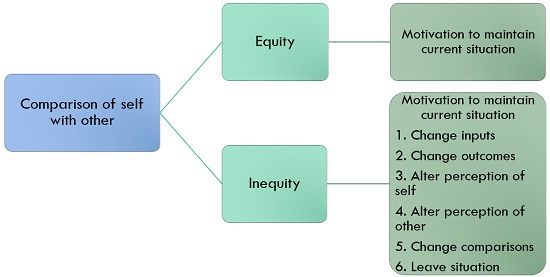What is Motivation? definition and theories – Business Jargons
Definition: Motivation is a driving force which affects the choice of alternatives in the behaviour of a person. It improves, stimulates and induces employees leading to goal-oriented behaviour.
For example, promotion is a motivating factor as employees work to achieve preset targets for getting a promotion. Motivation can be monetary, e.g., rewards given in the form of a car or a hike in the salary or it can be non-monetary in the form of public appreciation.
There are two types of theories in motivation: content and process theories.

- Content theories of motivation
- Maslow’s hierarchy of needs: Maslow classified human needs into five basic categories as shown in the figure.

- Physiological need: It is the basic form of need which includes food, shelter and clothing. E.g., getting a job for survival in the context of an organisation.
- Safety need: With physiological needs being met, a need for stability and safety comes into the picture. E.g., job security.
- Social need: It is a sense of belongingness to the society. In the context of an organisation, this simply means having good work relations with colleagues and superiors.
- Esteem needs: This includes admiration, status and self-respect. E.g., employees in an organisation need recognition for their efforts in achieving the predetermined goals.
- Self-Actualization: This is a need for personal development and self-fulfillment. E.g., growth in a profession or moving up the ladder in an organization. Maslow’s theory acts as a good base for managers to motivate employees.
Assumptions of Maslow’s hierarchy of needs:- Needs follow a hierarchy.
- The behaviour of people is based on their needs.
- A satisfied need stops being a motivator.
- People ascend from lower level to higher level of their needs. This means that lower category of need must first be fulfilled before progressing ahead.Maslow’s theory of hierarchy is universally accepted as it is simple and logical.
- Alderfer’s theory: Alderfer’s theory conceptualises human needs that are relevant to organisational settings. This theory is also known as ERG theory. Need category can be classified into three classes:
- Existence: this human need relates to survival which is similar to Maslow’s physiological and certain part of safety need.
- Relatedness: This is comparable to Maslow’s social needs and a certain part of esteem and safety needs.
- Growth: this includes personal development and growth. It can be related to Maslow’s esteem and self-actualization needs.
- Herzberg’s Motivator-Hygiene Theory: In this theory of work motivation, employees are given a questionnaire to understand:
- The factors that make employees extremely dissatisfied with their environment and workplace.
- The factors that make employees extremely satisfied with their environment and workplace.The reasons which give rise to satisfaction, Herzberg termed them as motivators, and those resulting in dissatisfaction are called as hygiene factors.
- McClelland’s Learned Needs theory: McClelland identified three motivators which drives people in the society to work accordingly:
- Need for Achievement: This type of need focuses on excellence and accomplishment of goals.
- Need for Power: This is a need of an individual which drives him to be competitive and influence others.
- Need for Affiliation: This is a personal need of an individual to develop and maintain good relations in the society.
- Maslow’s hierarchy of needs: Maslow classified human needs into five basic categories as shown in the figure.
- Process Theory of motivation: This involves the following three theories:
- Equity theory: Individuals are motivated by fairness, so if they perceive a fair environment, they will be motivated, and if they feel that the work environment is unfair they will be demotivated. In simple words, discrimination acts as a demotivating factor for employees in an organization.

- Vroom’s Expectancy Theory: Vroom studied people’s motivation and arrived at a conclusion that it depends on three factors, expectancy, instrumentality and motivation.
According to Vroom,

- Expectancy is the belief that the more efforts you put in, the better will be the result or performance. There are two types of expectancy: The Effort- Performance expectancy and the Performance-Outcome expectancy.
- Instrumentality is a notion that if you perform well, a desirable result will be received.
- Valence is the priority one gives to the expected outcome or result. Vroom differentiated between efforts people put in, their performance and the outcome. This principle works on perception.
- Porter-Lawler Model: This is an extended and polished version of Vroom’s expectancy model. It states that an individual’s motivation to finish an activity is driven by reward they expect to get on completion of the activity. The Porter-Lawler model is presented in the figure.

According to this model, efforts may not certainly produce job performance for the following reasons: Firstly, an employee may not be capable enough to perform the task assigned and the second may be that the employee lacks clarity of his job role.
- Equity theory: Individuals are motivated by fairness, so if they perceive a fair environment, they will be motivated, and if they feel that the work environment is unfair they will be demotivated. In simple words, discrimination acts as a demotivating factor for employees in an organization.
Motivation is thus an inner state of mind that directs one’s behaviour.















![Toni Kroos là ai? [ sự thật về tiểu sử đầy đủ Toni Kroos ]](https://evbn.org/wp-content/uploads/New-Project-6635-1671934592.jpg)


